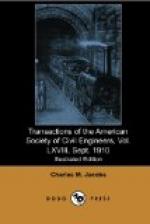Sixth.—The usual requirement
that the resultant of both horizontal
and vertical forces should,
at all points, fall within the middle
third of the wall, or, in
other words, that there should be no
tension in the concrete.
[Illustration: Plate LIV. Diagram Showing Widths of Base of Retaining Wall Required for Different Batters and Pressures, Pennsylvania Station]
With these assumptions, investigation was made of walls with various batters and differently designed backs. This investigation developed the fact that the reaction from the superstructure was so great that, for economy, both in first cost and space occupied, the batter must be sufficient to cause that reaction to fall within or very close to the middle third. Nothing could have been gained by having that reaction fall back of the front of the middle third, as the wall was required to be stable against the full pressure before the superstructure was erected, and in case it should ever be removed; or, to state the matter more clearly, the reaction from the superstructure was so great in comparison to the weight of the wall, that, if it fell in front of the resultant of all the other forces, the width of base required would be greatly increased to make the wall stable after the superstructure was erected; whereas, if the reaction from the superstructure fell back of the resultant of all the other forces, the width of base could not be correspondingly decreased without danger of the wall being overturned before the superstructure was erected. The least batter that would answer those conditions was found to be 2 in. per ft.
For convenience in designing, and economy in constructing, the steelwork, the faces of the bridge seat and of the backwall were laid parallel to the center line of the Terminal, and in elevation on line parallel to the top of the curb and as near to it as the economical depth of steel would permit, without bringing the finished construction above the plane fixed in the ordinance. As there is a variation of 13 ft. in the elevation of the top of the curb of 31st Street above the top of rail and a variation of 18 ft. in 33d Street, a uniform batter, with the top parallel to the center line, would produce a toe varying in distance from it and from the other constructions. It was decided, therefore, for the sake of appearance, to make the face of the wall (or wall produced) at the top of rail parallel to the center line, and to vary the batter accordingly, using the 2-in. batter previously mentioned as the minimum. This gave a maximum batter of 3 in. per ft. The variation is so gradual that it is unnoticeable, and is not sufficient to introduce any complications in construction.




